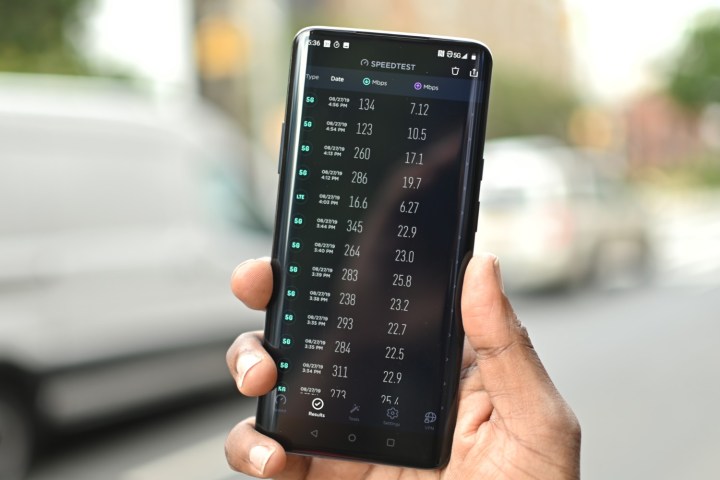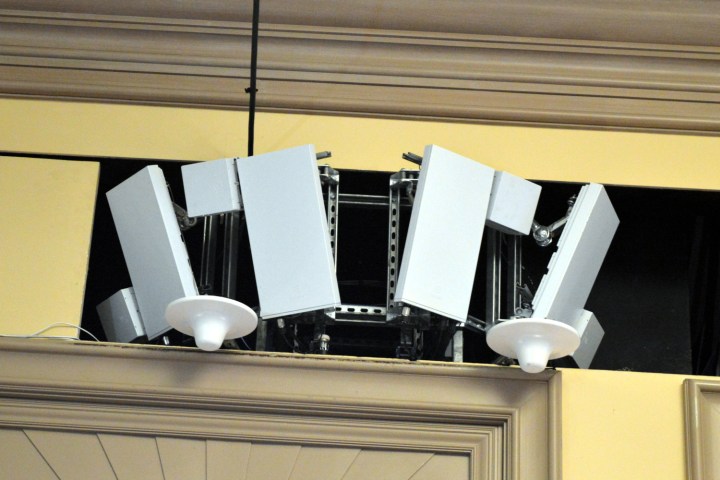
5G in 2020: 8 Things You Really Need to Know Right Now
The buzz around 5G has been heating up lately, and for good reason. We’re finally starting to see the first widespread 5G network deployments, and 2020 promises to bring a host of 5G phones, including the first budget and midrange models. There’s a chance that if you buy a new phone this year, it will support 5G.
But what can you really expect from 5G in 2020? The technology’s quite new, and there aren’t too many “killer applications” just yet. We’ve separated fact from fiction for you in this list of eight things you need to know about 5G right now.
1. Superfast 5G is still a novelty
 Julian Chokkattu/Digital Trends
Julian Chokkattu/Digital Trends
Before you get all excited about multi-gigabit 5G speeds on your shiny new 5G phone, chances are you won’t see them very much, if at all, during 2020. These speeds require a technology known as mmWave, which operates at extremely high frequencies. At these higher frequencies, radio signals can’t travel as far from towers, requiring “mini-towers” every so many blocks to provide a stable connection. This means these connections may be limited to the big cities — and often only in select neighborhoods, as they’ll take a little longer to build.
2. You might not notice much of a difference — at first
 Julian Chokkattu/Digital Trends
Julian Chokkattu/Digital Trends
Even in areas where 5G coverage is more expansive (and lower frequencies are being used to provide it), you might find yourself hard-pressed to notice a difference in download speeds. While many of us will see a definite speed bump into the hundreds of megabits per second (especially those using T-Mobile’s 5G network, which uses low-band, 600MHz signals), it won’t be that much of a jump in overall performance this year. Think evolutionary rather than revolutionary. That’s because carriers are pairing 4G and 5G networks to speed deployments, and concentrating on breadth of coverage rather than speeds. But when networks get tuned for speed, watch out!
3. There won’t be a killer app
 Image used with permission by copyright holder
Image used with permission by copyright holder
Despite the claims of how 5G will change the way we live — improving our gaming, transforming our cars, and more — we all need to take a step back and realize that we’re only in year two of a journey that will likely take most of the decade. LTE took nearly a half-decade before networks were robust enough to provide reliable, broad-based coverage — and some rural areas still don’t have LTE nearly a decade later. Similarily, 5G likely won’t take as long thanks to advancements in wireless technology, but still, the idea of connected cars and always-on IoT devices is still many years away.
4. 5G phones will actually be affordable
 Andy Boxall/Digital Trends
Andy Boxall/Digital Trends
While we did see quite a few 5G phones announced during 2019, there weren’t many that we could honestly call “affordable.” Most of these phones retailed for $1,000 or more. For 2020, Samsung set the bar with the new Galaxy S20, which starts at $1,000. But other phone makers are keeping prices surprisingly low: LG promises that the V60 ThinQ 5G will be under $1,000, for example, while the OnePlus 7 5G is around $800. This should improve during the year, but they’ll still remain close to that $1,000 price point. With cheaper 5G chipsets on the way from Qualcomm, there should be more options later in the year as well.
5. Cable internet will finally have a competitor
 Julian Chokkattu/Digital Trends
Julian Chokkattu/Digital Trends
While using 5G on a mobile device might be a bit of a challenge in 2020, the idea of using 5G as a fixed internet option will grow this year. We fully expect to see a host of 5G hot spots during the year, and many carriers have either indicated or announced that they plan to offer home 5G options. Even with “slower” 5G options, the speeds will be roughly the same as a standard cable internet connection. We can only hope this competition helps to bring prices down.
6. 5G will find its way into everything

CES 2020 brought us a host of 5G laptop announcements, but laptops are only the tip of the iceberg when it come to 5G. With the cost of 5G chips on the way down, electronics manufacturers will begin building 5G into a wide variety of electronics. Expect tablets and even smart devices to gain 5G support during the year. A word of warning, however: Like the first phones, these devices will also be initially expensive — but it’s a sign that the often-hyped connected future of 5G is becoming a reality.
7. 5G will be in the news — a lot
 Theo Wargo/Getty Images
Theo Wargo/Getty Images
As 5G rolls out during 2020, expect the technology to be in the headlines with ever-increasing regularity. Not all of it will be positive, however. Municipalities are becoming frustrated by the Federal Communications Commission’s push to streamline the approval process for the mini-towers that will make 5G’s superfast connections tick, and there will be continuing critiques of 5G’s “safety,” even though an international panel of experts say 5G is safe. Still, 5G will change our lives. It’s not a question of if, but when.
8. 5G is safe
 Image used with permission by copyright holder
Image used with permission by copyright holder
Despite the claims of its detractors, 5G is safe. After numerous studies, including one that involved an international panel of experts, there is no concrete evidence that radiation from 5G phones poses any more risk than your standard cell phone. So, no, your 5G device will not irradiate you, and it’s completely safe to use.


